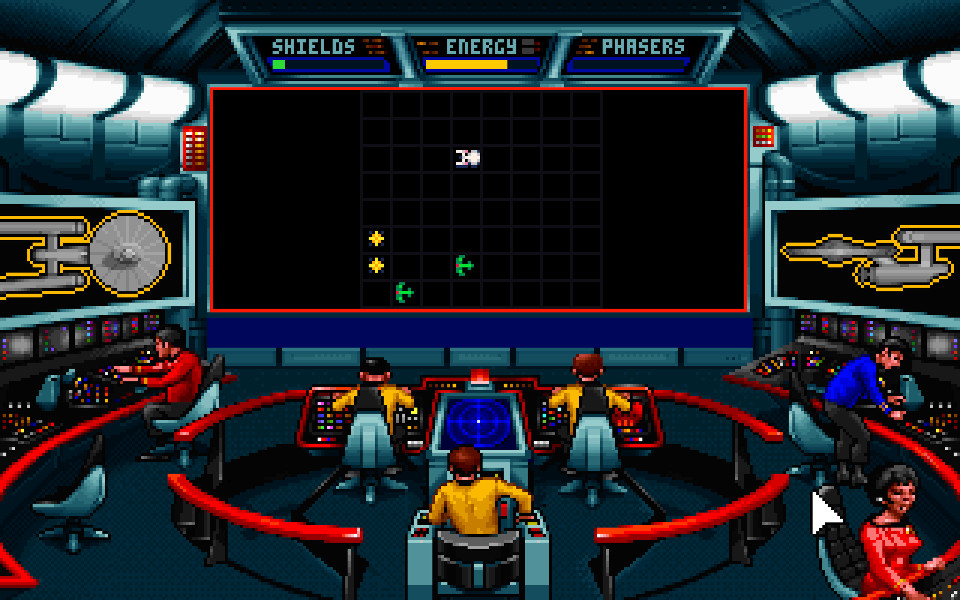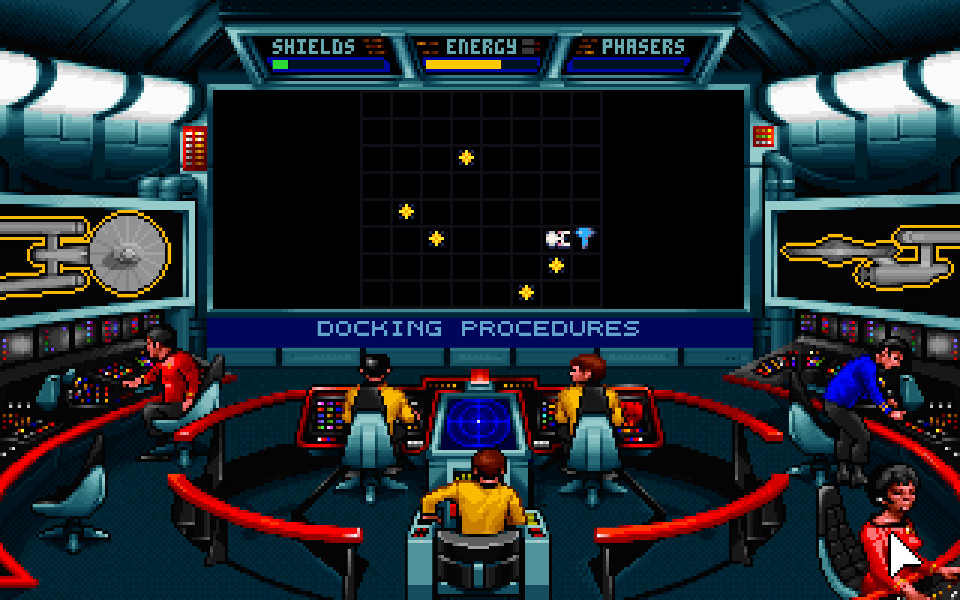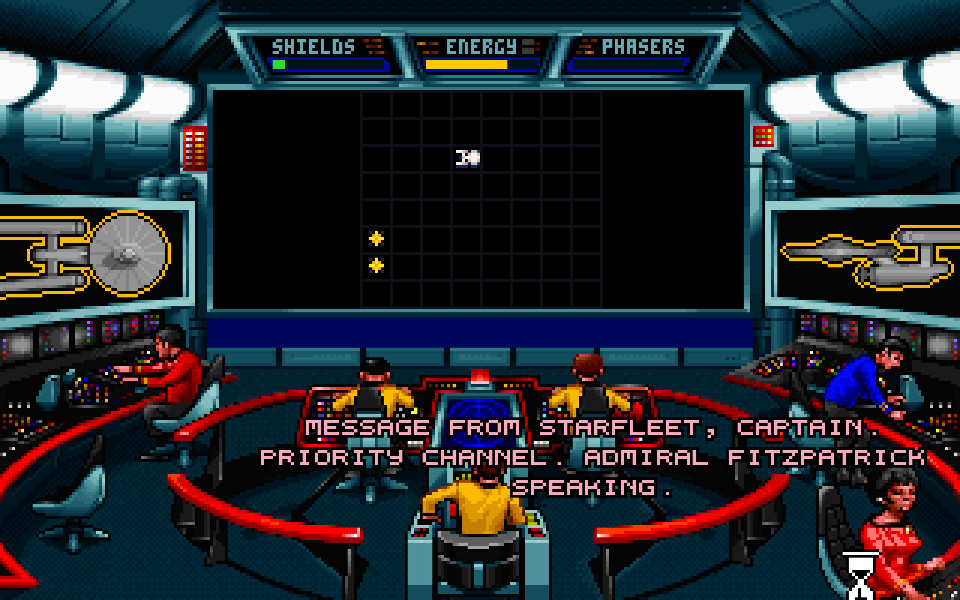For a certain type Star Trek fan, this is the coolest thing ever — Emanuele Bolognesi has taken the original, classic 1970s quadrant-sector Super Star Trek computer game and melded it with the interface of Interplay’s Star Trek 25th-Anniversary, resulting in the perfect marriage of gameplay and aesthetics.

I discovered it last night, through an article in PC Gamer, quite by accident. First, I played it on Bolognesi’s coding website, then downloaded the Windows executable and set it up in Wine on my Linux Mint install. (I even made an icon for it, using the delta pin teaser posters of the 2009 Star Trek film. Screenshots are taken from Mint.) Man, it brings back memories.
I can’t really do justice to the history of Super Star Trek — there are whole websites devoted to it, including an a piece by Dayton Ward, who played it on teletype! — but the basic story is this. In the early 1970s, a Star Trek fan named Mike Mayfield wrote the original version of the game. In the game, the Klingons invaded the galaxy (divided into 64 quadrants, each with 64 sectors), and you, in command of the Enterprise, have to explore the galaxy and destroy the Klingon fleet before they destroy the Federation. The game was updated by David H. Ahl, and then expanded by Bob Leedom, and their version, Super Star Trek appeared in Creative Computing in the late 70s and in Ahl’s Basic Computer Games. Then other programmers took the game and ran with it, adding features, porting it to different programming languages (like Fortran and C), and there are even modern versions that run in Java and Python. Along with Rogue, Super Star Trek is probably the first “viral” computer game.
I’ve had a photocopy of the Creative Computing listing since the early 80s. In all honesty, I never did anything with it. I had a TRS-80 Color Computer 2 in those days, with its 32 x 24 screen, and that was just too small to really do justice to the game. Plus, there was a bit of laziness involved; the code was just so long. But I’d look at my photocopy from time to time and think about it. I’d follow the code in my mind. I was in love with the idea of it.
In high school, I actually played a version of Star Trek for PC compatibles, but it wasn’t Super Star Trek. There were cool additions. The Klingons had a Commander, who could move from quadrant to quadrant. Romulans occasionally showed up, and if you left them alone they’d leave you alone. There were wormholes. Sometimes you had to mine dilithium because you needed energy. Stars could go nova. You could abandon ship and take command of an old scow, the Faerie Queene. And there were random quotations of the Meditations of Marcus Aurelius. I would love to find this version of the game, which is how I came across Bolognesi’s game.
This fan game, which takes the interface of Star Trek 25th-Anniversary and uses it to play Super Star Trek doesn’t have any of those cool additions. But that doesn’t make it any less worthwhile. You get a lot of Star Trek flavor, seeing and hearing the original cast, even McCoy, who occasionally pipes up from Sickbay if the ship takes too much of a beating in battle. It amused me to see the way Kirk sits in his command chair and moves back and forth, all nervous energy. The starbases look a bit like Spacedock from Star Trek III, but I’d like to think, given the era, that they’re sister stations to Vanguard from David Mack, Dayton Ward, and Kevin Dilmore’s Star Trek: Vanguard novels. The only thing I might add to it is the quadrant naming scheme from Super Star Trek — Altair IV, Deneb II, Vega I, etc.

The game is more luck than skill. A system breaks at an inopportune time, the Klingons start out just a little too spread out across the galaxy, there’s only a starbase or two and it’s inconveniently placed, and it’s unwinnable. It’s too easy to run out of time in Super Star Trek.
The whole thing feels like the Star Trek game for the Super Nintendo or Sega Genesis you always wanted but never had. It’s a fun way to spend half an hour, saving the galaxy from a Klingon invasion. If you’re that certain type of Star Trek fan, like I am, give Bolognesi’s Super Star Trek a try.



Thanks a lot for the article! I’m glad you liked it! My goal was to recreate the Star Trek atmosphere, and somehow I did it. I must find the version of the game you mentioned, the one with the quotations from the Meditations; it seems very interesting. I tried a lot of remakes, but in the end, I prefer the simplicity of the 1978 Super Star Trek. The combination of simple rules, limited resources, and random events is an excellent example of game design.
Luck plays an important role, but if you find the time to play a bit more, I believe you will discover that the game is not “more luck than skills”. Especially at difficulty 4, you must avoid useless warp jumps, decide the right path to explore the galaxy, and use torpedoes as much as possible (in some cases, it’s better to take a hit and move and then use torpedoes rather than waste energy of phasers, especially if the enemies are far). There are a lot of possible strategies. I suppose I have to write a strategy guide or something 😀
I’ll let you know when it’s ready. Thanks again!